
SHARED FROM AUSTEN AUTHORS
Do you just love those scenes in Jane Austen fanfiction where a couple we care about elopes to Gretna Green?

Whether it’s Darcy and Elizabeth or some other couple we are rooting for, it seems so romantic to picture them rushing off to be married. Of course, we also cringe when a naughty couple such as Wickham and (fill in the blank) do the same. Still, I love to read about Gretna Green, and I thought I would share just a little about this life-changing village in Scotland and why it became legendary.

The reason for the exodus to Gretna Green was the Marriage Act of 1753—Lord Chancellor Hardwicke’s Act for the Prevention of Clandestine Marriages. The law passed after a good deal of debate about regularizing marriages to protect wealthy families from having their offspring preyed upon. Prior to this, London was infamous for “Fleet marriages” performed by clergymen who were in Fleet Prison for debtors.

Clergymen could live in the “Rules” area, just outside the prison (meant to provide them a sanctuary) and there they performed questionable marriages. They could not be fined for performing these marriages and were effectively beyond the law. The Fleet weddings were the bane of many a rich family. Underage heiresses were tricked or kidnapped and forced into marriages by unscrupulous men. Fathers also complained of sons who had married unsuitable brides. Even two dukes saw their sons married in these secret ceremonies. However with the Marriage Act, by 1754 the informal wedding had been swept away.
Under the act, clandestine or common-law marriages in England were made illegal. Now marriages required an official ceremony performed by a Church of England priest, unless the couple was Jewish or Quaker. The groom and bride had to each be 21 years of age, or have the consent of their parents or guardians. The wedding had to take place during daylight hours in a parish church within the Church of England’s jurisdiction. Banns had to be read for three Sundays prior to the ceremony, and the curate would ask if anyone knew any reason why either the man or woman could not marry. If the couple lived in separate parishes, the banns had to be called in each. Lastly, a license had to be obtained and the marriage recorded in the parish church.
Special Licenses avoided all these requirements but had to be obtained from the Archbishop of Canterbury, and the names of those to be married had to be written on the license. These constraints did not help those wishing to marry against the wishes of their families. By requiring parental consent, the act gave parents the right to reject any marriage they considered undesirable. A clergyman who performed an illegal marriage could be transported for up to fourteen years. Yikes!
and the names of those to be married had to be written on the license. These constraints did not help those wishing to marry against the wishes of their families. By requiring parental consent, the act gave parents the right to reject any marriage they considered undesirable. A clergyman who performed an illegal marriage could be transported for up to fourteen years. Yikes!
This act also applied in Wales and Ireland. However, it did not apply to Scotland which was under its own legal system and where the age of consent was 12 for girls and 14 for boys. Hence marriages at Gretna Green became popular. It was not the only Scottish Border village destination, though it was the first village over the border on the main west coast route from England. It was not the closest place if you went north from London. If you went up the Great North Road to Scotland, it would take you to Coldstream Bridge or Mordington or Lamberton Toll, all on the eastern side of the country.
Moreover, marriage records show a number of Irish couples married in Scotland to thwart the Irish marriage laws. Gretna Green was not the most popular venue for the Irish, however. Instead they headed for Portpatrick in Wigtownshire on the far west coast because there was a daily packet boat service from Ireland to that village. Finally, the eloping couple didn’t necessarily need to go to Scotland at all. The Channel Islands and the Isle of Man also allowed for clandestine marriages before their laws were changed.
 One had to be absolutely certain they were in Scottish territory when the marriage took place. The Berwick toll keeper, who usually presided over the weddings for those who crossed into Scotland there, was sent to prison for performing a ceremony in Berwick town itself, which was in England.
One had to be absolutely certain they were in Scottish territory when the marriage took place. The Berwick toll keeper, who usually presided over the weddings for those who crossed into Scotland there, was sent to prison for performing a ceremony in Berwick town itself, which was in England.
Under Scotland’s irregular marriage traditions, anybody could perform marriages whether they were farmers, the blacksmith, the toll masters, the landlord of the local tavern, a passing highwayman or a local smuggler. So, contrary to the common tradition of “anvil priests,” the blacksmith was not the only person who could marry a couple.
After reading this, I began to wonder if I would actually feel married if the ceremony was performed by a blacksmith, much less a highwayman or smuggler! How binding would that seem? I would love to hear your views on the subject.
Information in this post came from the following: http://wordwenches.typepad.com/word_wenches/2013/11/ten-fascinating-facts-about-gretna-green.html and https://en.wikipedia.org/wiki/Shrigley_abduction
I had new covers created for my books, “Fitzwilliam Darcy An Honourable Man” and “Mr. Darcy’s Forbidden Love” and in celebration, I am giving away a Kindle e-book of each. Just leave a comment to this post by Midnight Friday (CST) if you would like to be in the drawing. 

































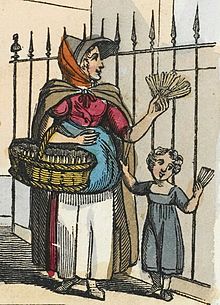 “match” was known in Europe, but it was much more similar to what we think of as a wick or a fuse. It was a chemically treated cord which burned slowly but continuously, and could be used to ignite the touch-hole of a cannon or a campfire.
“match” was known in Europe, but it was much more similar to what we think of as a wick or a fuse. It was a chemically treated cord which burned slowly but continuously, and could be used to ignite the touch-hole of a cannon or a campfire.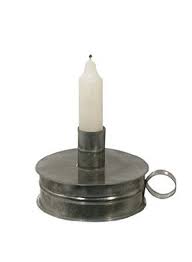 place for a candle so that you could use it as a holder if you wished.
place for a candle so that you could use it as a holder if you wished.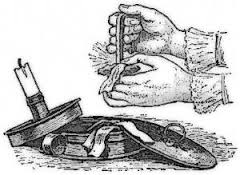 encouraged by a few soft, steady breaths. Once the tinder was burning steadily, a match was applied to it. The match would ignite and be applied to a candle for light, or to a taper or paper spill to be used to light a fire laid on the hearth. As soon as the match had been ignited, the damper was put back into the tinderbox to snuff out the tinder so that it could be used again.
encouraged by a few soft, steady breaths. Once the tinder was burning steadily, a match was applied to it. The match would ignite and be applied to a candle for light, or to a taper or paper spill to be used to light a fire laid on the hearth. As soon as the match had been ignited, the damper was put back into the tinderbox to snuff out the tinder so that it could be used again.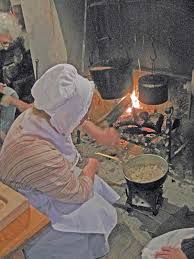 smoldering embers and then add fuel to renew the fire. As it was not always convenient to dash to the kitchen hearth for a light, many homes kept a tinderbox on each mantelpiece. A thoroughly utilitarian domestic appliance, a tinderbox might be kept out of sight in an elegant town home or an opulent country mansion, except for those made of brass or silver. Still, it was a common feature of modest houses and cottages.
smoldering embers and then add fuel to renew the fire. As it was not always convenient to dash to the kitchen hearth for a light, many homes kept a tinderbox on each mantelpiece. A thoroughly utilitarian domestic appliance, a tinderbox might be kept out of sight in an elegant town home or an opulent country mansion, except for those made of brass or silver. Still, it was a common feature of modest houses and cottages.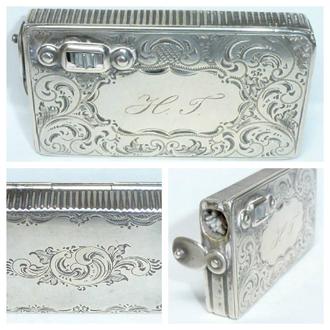
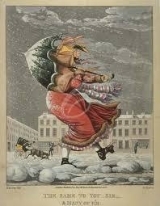 Being born and raised in the southern United States, I have never been a fan of cold weather. While I don’t care for really hot weather either, if I had to choose between sweating to death or being turned into a popsicle, I would definitely choose the former.
Being born and raised in the southern United States, I have never been a fan of cold weather. While I don’t care for really hot weather either, if I had to choose between sweating to death or being turned into a popsicle, I would definitely choose the former.
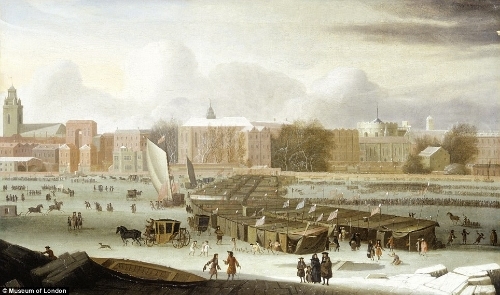 Moreover, it was said that there were up to ten printing presses in operation making cards and popular sheet-music of the time. A printer named George Davis published a 124-page book, Frostiana: or a History of the River Thames in a Frozen State, and the entire book was type-set and printed in Davis’s stall. Unlicensed gambling, drinking and dancing were likely the greatest draws at the fairs, there were stalls selling food, drink, souvenirs and personalized keepsakes for just a few pennies. Featured in the Museum of London’s
Moreover, it was said that there were up to ten printing presses in operation making cards and popular sheet-music of the time. A printer named George Davis published a 124-page book, Frostiana: or a History of the River Thames in a Frozen State, and the entire book was type-set and printed in Davis’s stall. Unlicensed gambling, drinking and dancing were likely the greatest draws at the fairs, there were stalls selling food, drink, souvenirs and personalized keepsakes for just a few pennies. Featured in the Museum of London’s 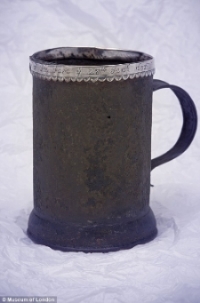 set of memorabilia are a souvenir tankard from the frost fair of 1683 and a souvenir silver spoon from the frost fair of 1683 to 1684.
set of memorabilia are a souvenir tankard from the frost fair of 1683 and a souvenir silver spoon from the frost fair of 1683 to 1684.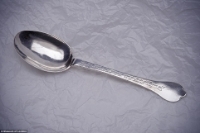 the 29 of January 1683/4.’
the 29 of January 1683/4.’


